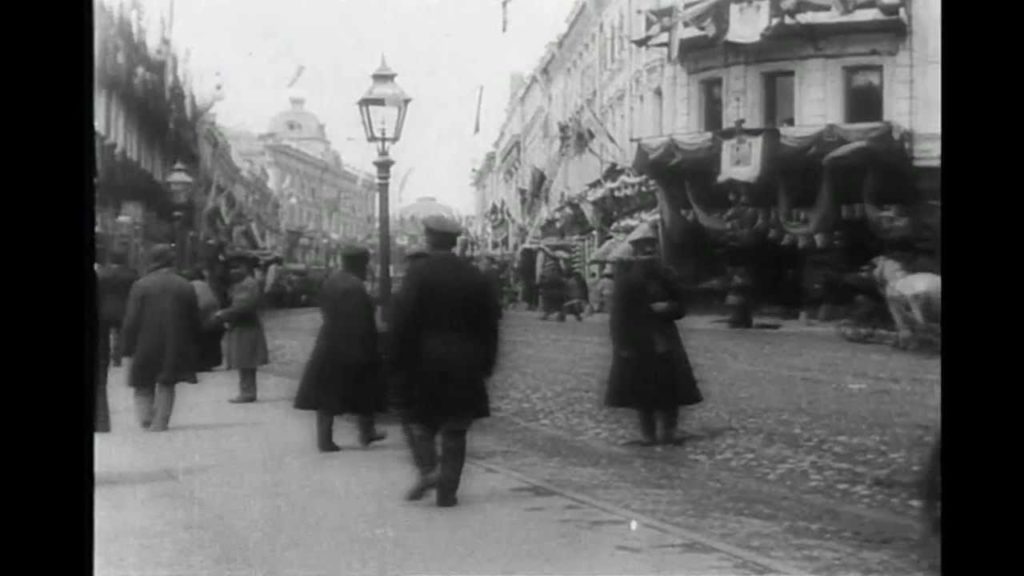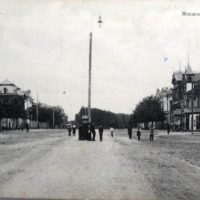
Related

Moscow Street. 1900s. Kovrov, Vladimir Gubernia, Russia

Vladimir - city hall and The Great Moscow Street. Stone building of the late XVIII - XIX centuries.

Moscow Kremlin in 1896, Russian Empire, 19th century

Moscow street. Vladimir, central Russia

Vladimir - city hall and The Great Moscow Street. Stone building of the late XVIII - XIX centuries.

Moscow mansion of beginning of XIX century. Alexander I and the year 1912. Engravings. Art Album.

Moscow street. Vladimir. Russia

Kovrov, Vladimir Gubernia, Russia, Moscow Street. 1900s

Moskovskaya street, Tashkent, Uzbekistan, 1910s
Moscow. Tverskaya Street at the end of the 19th century. The year 1896. Tverskaya Street 19th century.
Summary
Тверская улица в конце 19 века. 1896 год. На видео ошибочно было указано, что съёмка производилась в Санкт-Петербурге. На самом деле это Москва. Это же подтверждает комментатор видео.
Из киносборника "Первые фильмы братьев Люмьер" / "The Lumière Brothers' First Films", составленным французским кинорежиссером Бертраном Тавернье из более чем 1500 картин компании "Люмьер", хранящихся в архивах Института Люмьер в Лионе.
Киносъёмку проводил оператор компании «Люмьер» Камилл Серф, прибывший в Москву по случаю коронации Николая II, которая проходила 26(14) мая 1896 года.
Справа на видео мы можем наблюдать гостиницу "Париж". Известно, что это был гранд-отель на 88 номеров. Он был популярен из-за дешевизны номеров (цены в «Париже» были в два раза ниже, чем через дорогу в «Национале») и удобного расположения. «Париж» был снесен вместе с другой исторической застройкой при расширении Тверской улицы в 1935 году. На месте, где стоял этот дом, сейчас проходит проезжая часть Тверской улицы. Тверская улица в 20 веке: в 1923 году
There were special court cameramen and photographers who captured the daily life of the Romanov family. The Company of von Gun filmed the Tsar, and with the permission of the Ministry of the Court, showed these films in movie theatres beginning in 1907. Before the February 1917 Revolution, the von Gun Company was the main provider of the Tsar's chronicles in the Russian film industry. After 1907 other filmmakers were permitted to film the Royal family, including A. Drankov, V. Bulla (the elder), Khanzhonkov Company, Pate Company, and others. Before the beginning of World War I a newsreel became popular capturing military parades, holidays, reviews and drills. Many are devoted to the Fleet. They document everyday life of the Baltic Sea and Black Sea squadrons. Some of the newsreels document the fire of the Maly Theatre in Moscow, mass gymnastics, auto and motor races, zoos and animal preserves, and the life of peoples of the Russian Empire. The objects of filming were political and cultural figures, the construction of warships, the Moscow flood, the testing of new agricultural equipment and the oil industry in Baku. There are also films showing the towns of Russia, etc. During World War I, cameramen captured events on all fronts. Before 1915, the exclusive rights to film battles belonged to the Film Department of the Skobelev Committee. The Skobelev Committee of the Assistance to the Wounded Soldiers of the General Staff was founded in November 1904 as a public organization. By the order of the Scobelev Committee many cameramen filmed the events of the World War I, such as Englishman Arcol (representative of Pate Company, filmed on South-Western and Caucasus fronts), cameramen E.D. Dored (represented American companies) and P.V. Ermolov, (filmed events on Caucasus front); P.K. Novitskiy (Gomount Company), N.M. Toporkov, K.E. von Gan, A.K. Gan-Jagelskiy, made filming in the General Headquarters. Other cameramen such as: A. G Lemberg, S, Zebel, Trushe, etc. also worked at the fronts. Cameramen filmed the war not only on the fronts but also from the rear. Since the first month of the war until 1917 the Scobelev Committee produced about 70 newsreels. From 1914 to 1915 cameramen of the Scobelev Committee produced 21 series of the newsreel "Russian Military Chronicle". The materials of this newsreel were used many times for the separate films made by Scobelev Committee and other film companies. Read more at: http://www.pbs.org/redfiles/rao/archives/rgakfd/textind10.html
- Saint-Pétersbourg, Rue Tverskaïa (Short 1896) - IMDb
- Г. Москва. Тверская улица в конце 19 века. 1896 год. Тверская ...
- Москва. Тверская улица в конце 19 века. 1896 год ... - YouTube
- Г. Москва. Тверская улица в конце 19 века. 1896 год ... - PICRYL
- Маллиотт Тверская Гостевой дом Москва, Россия - Micoope
- tverskaya street - Romanov Empire - Империя Романовых
- English: Arseni of the Tempera and Russia 19th 29x24 Русский
